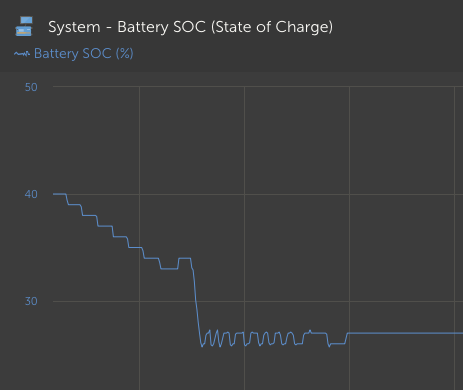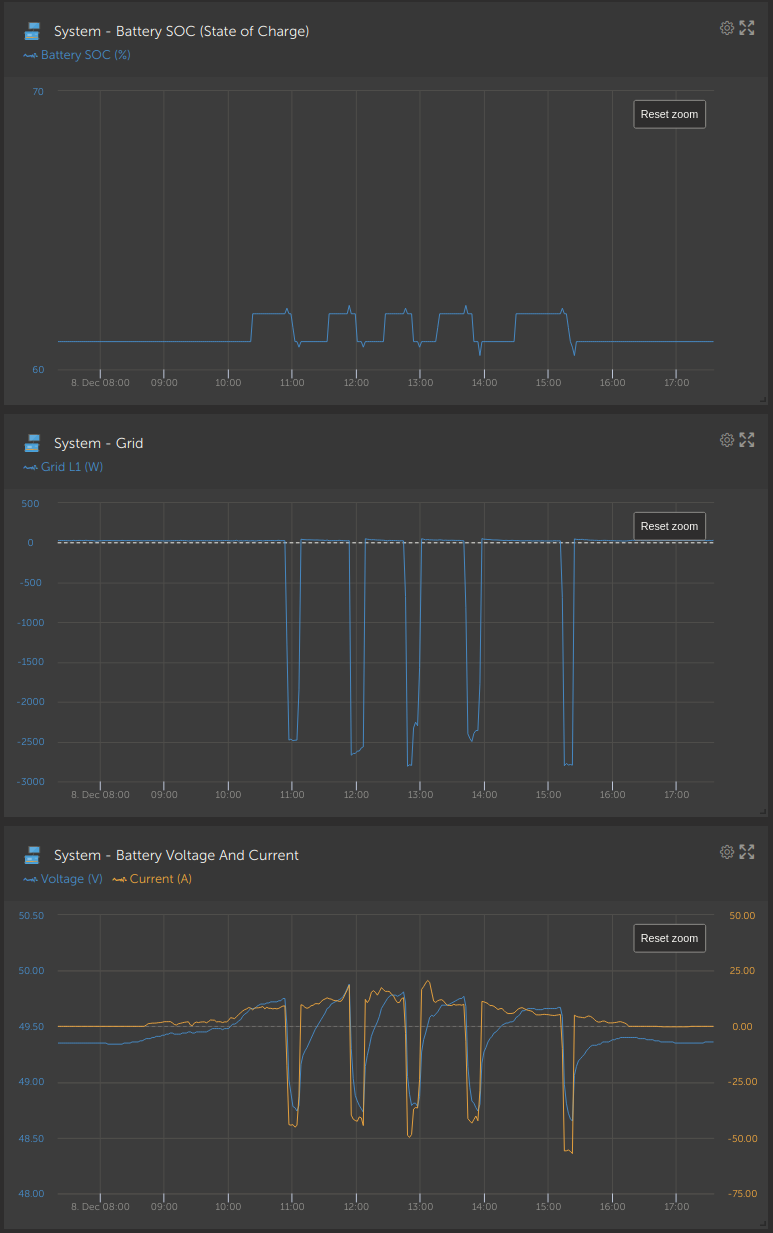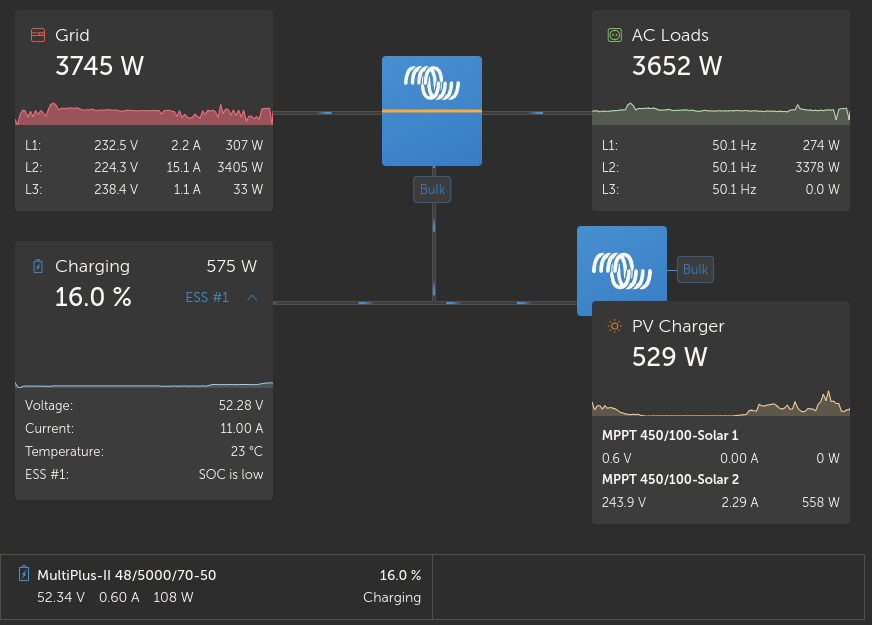Hello,
I would like to raise a question (or maybe three of them) to the Victron.
The main Question or more a complaint or how the report of "strange behaviour" should be called - in regards of loosing the battery round-trip energy and aging the battery "artificaly" during "darker days".
3phase EES system of
Cerbo Gx (fw3.10),
3x Multiplus 5000/48 70 (fw506),
4x Pylontech US3000C (with korona chips),
grid feed-in enabled, optimised without battery life,
"individual phase regulation" because of the local "per phase" metering,
SmartSolar MPPT VE.Can 150/70 rev2 v3.13,
SmartSolar Charger MPPT 150/45 rev3 v1.61,
SmartSolar Charger MPPT 150/35 v1.61,
external grid meter (ET340),
some loads between external grid meter and AC in (heat-pump to be exact)
critical load on AC out.
1) The "behaviour/problem" :
On the "darker days" - whenever the system is on "minimal SOC until grid fails" there is the "unwanted feature" of using the solar to charge the battery to "minimial SOC"+10% of minimal SOC. (do not know why..) Yes, it is "ESS optimized without battery life". And after this Minimal SOC+10% is reached the "freshly charge" is again taken from the battery and the battery and solar feed the loads, until the minimal SOC is reached again - then this theatre starts again and the battery gets again charged 10% up by solar, loads are again covered from grid. And again and again.
Example : (almost real life - darker day, not too high consumption): "constant" 300W DC solar input, 600W "critical" loads, Minimum SOC until grid fails 30%.
1.1) Starting with battery on the 30% SOC in the morning .. 300W used for charging the battery (why??), 600W from grid used to cover the loads (Why does not the system just cover 50% of the load with the DC connected MPPTS output and rest from grid, and leave the battery "sleep"??)
1.2) 33% battery SOC (meaning 30% + 10% of 30%) gets reached (as said charged by solar, but loads covered by grid ..)
1.3) Battery and solar are used to feed the loads - again until 30% min SOC is reached. (just discharging the "few minutes ago" charged battery charge.
1.4) The cycle starts from beginning.
Would this (unwanted charge/discharge cycle) last with the "actual battery bank capacity" for lets say 2 hours (for better numbers, in real it is shorter - like hour ..) - then 600W from grid would be used to cover the loads and 300W of solar would go to battery and the 2nd hour 300W of solar and 300W from that "now charged a bit up" battery cover the loads.
Wondering why this "buit in rule" has to be there - just "loosing the battery round-trip energy and aging the battery" (credits to @beat for the proper wording - not native english speaker here). Where when you look at the SOC or the "grid usage" graphs - it looks crap - like a lawn rake -_-_-_-_ (battery, and the grid is in inversion to it the whole day) - hour charging (and consuming the grid), hour discharging, through the whole day - "mini" cycle after cycle - just burning the energy with charging/discharging and cycling the battery. (sorry, not electrician or as deeply familiar with the "electrical part" of the system, just seing the "unexpected behaviour" as also the "broken" premise "loads first").
Where the documentation "all around" is stating a premise that the behaviour is simple "first loads, then battery, then feed-in .. " - not in this case.
2) Where 2nd "tiny point" - based on recent try of "with battery life" set - also there is the behaviour a bit strange. Not only the "protection of virtual SOC" is provided, which is for sure nice (at least for lead acid), but also the "battery first, loads later" behaviour in the morning gets broken. (have choosen "with battery life" while trying to avoid/delay the "high voltage alarms" caused by "very slow Multiplus feed-in start" - causing too high charge current, even battery has minutes ago asked to drop it at the battery near to charged (~95 SOC), causing cell imbalance - probably as result of slow "multiplus reaction" after feed-in has been enabled - effectively "disabling" the MPPT throtling the gains. (the later (high voltage alarms) here is not a small issue either, but hope to have possible solution with dropping the charge voltage a bit - needs to be tested by the installer.)
Meaning in this 2nd point :
2.1) Problem the Sunny days - in the opposite, when setting (July this year - gathering the feed-in for "winter" based on grid contract, "without battery life") the grid DC feed-in (limited to 7K - limit never reached) - yes, it disables the MPPT throtling, fine so far. But for some reason the Multiplus does very very slow react on the battery bank BMS request to drop the charge current (around 95% SOC - still getting 2kW+) and only very slowly (and in up to 5 minutes delayed per step) starts and (still minutes later) increases the grid feed-in (in what it looks like 600W steps). (as user not having the chance to re-enable MPPT throtling, nor having insigt what, whether LOM, hidden "network requirements" or what is causing the Multipluses to take ages to "get rid of the surplus" to the grid. In end-result causing again "attack on the battery" - flooding it until cell imbalance and "up to 12 times high voltage alarms around the time of switch from "bulk" to "absorption" making the brick to deny charge (and high probably loose health..)
2.2) When setting the "with battery life" - have expected the system to "setup a virtual limit based on the daily solar gain to keep the battery better charged" (yes, the 80%SOC +-5% .. etc..) - but wondering now - why yes, one day ended on the "virtual SOC" .. but the next day morning starts with 5% battery charging (or more ??), before the solar is used also for loads .. This is somehow again "agains the premise of loads first, battery seccond".
So where is now the truth, why I cant get rid of the feeling, that the ESS with DVCC (and for user disabled (or editable, but ignored) limits and disabled shared stuff inside of DVCC - like "max charge current deactivated", MPPT throtling deactivated) behaves like the "battery enemy" - "high current", "unnecessary charging and discharging cycles" - and all that with "External control of the BMS" and "ESS#1", "ESS#2" ... Beside of that breaking some of the basic rules (which sound nice and promissing) described in the documentation.
3) And "last surprise" at the end - met the "Self consumption from battery" - "Only critical loads" option - wondering why does this work (according to documentation) only for systems with disabled feed-in ?? (as if during the night, where you would like to conserve energy for maybe critical loads, or "leave the non-critical ones to be covered by grid" the feed-in does not play any role (leaving out the dynamic ESS in my thoughts). And during the day - there is either enough solar to cover the critical loads, the non-critical loads, feed the battery and maybe even feed in. Without feed in - the "equation" seems almost the same - except maybe "battery flood" caused by "enabled but inactive feed-in" while having stopping extensive non-critical loads - which again seems similar to the 2.1. - "burning the battery". Missing somehow the point, where is the difference "not to discharge battery" for the non-critical loads - with or without feed-in enabled. (in perspective of non-critical loads between external grid meter and ac-in). And yes - with heat-pump as "non-essential" load - I would like (and was looking for - when reading about this feature) to leave it out from the battery cycle - as it would just drain the bits soo fast during the winter "dark" days.
Really thank You - for the energy and effort in case someone kept reading my long post until here.














